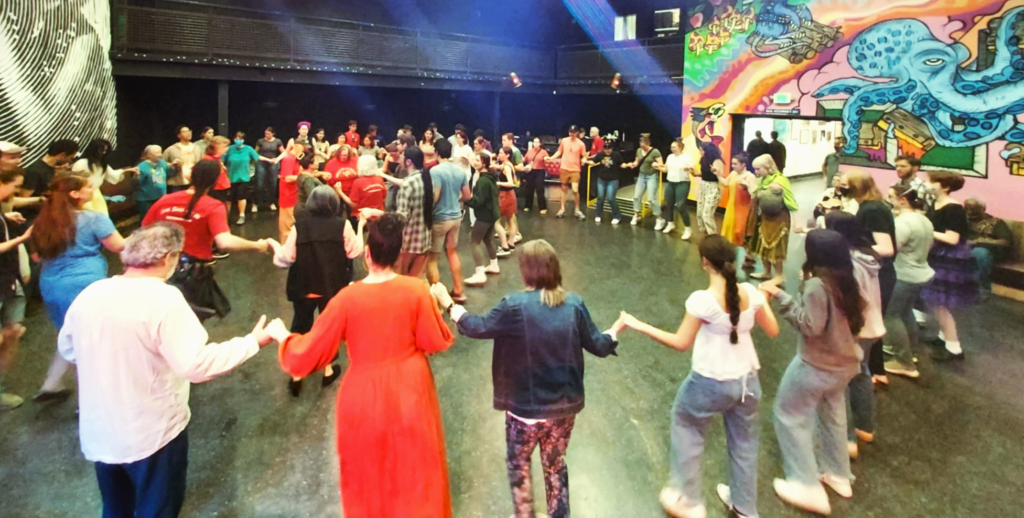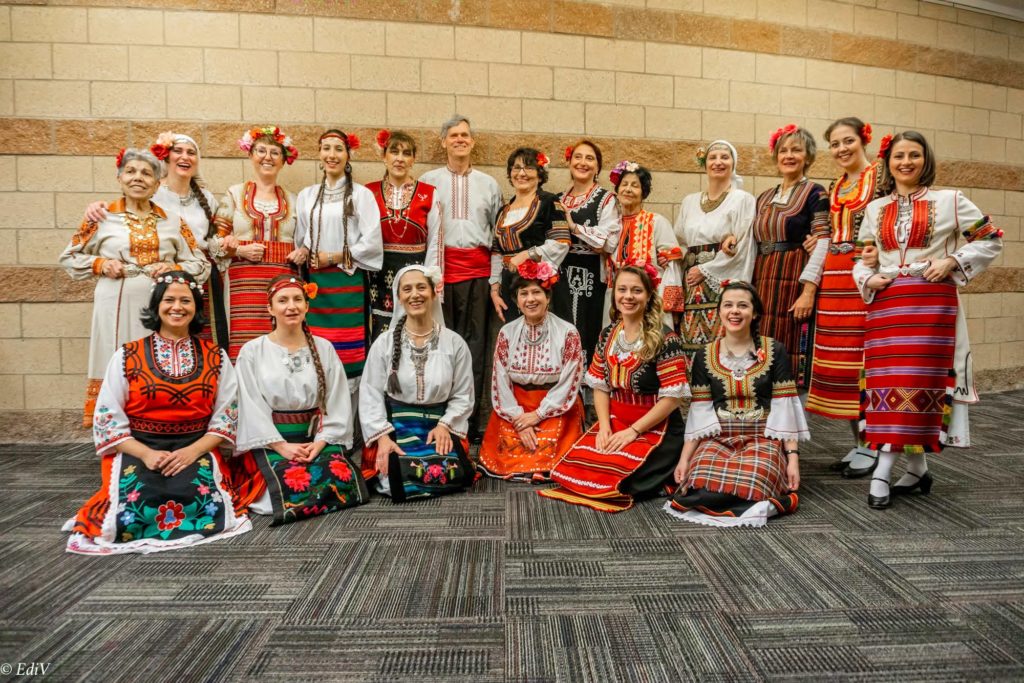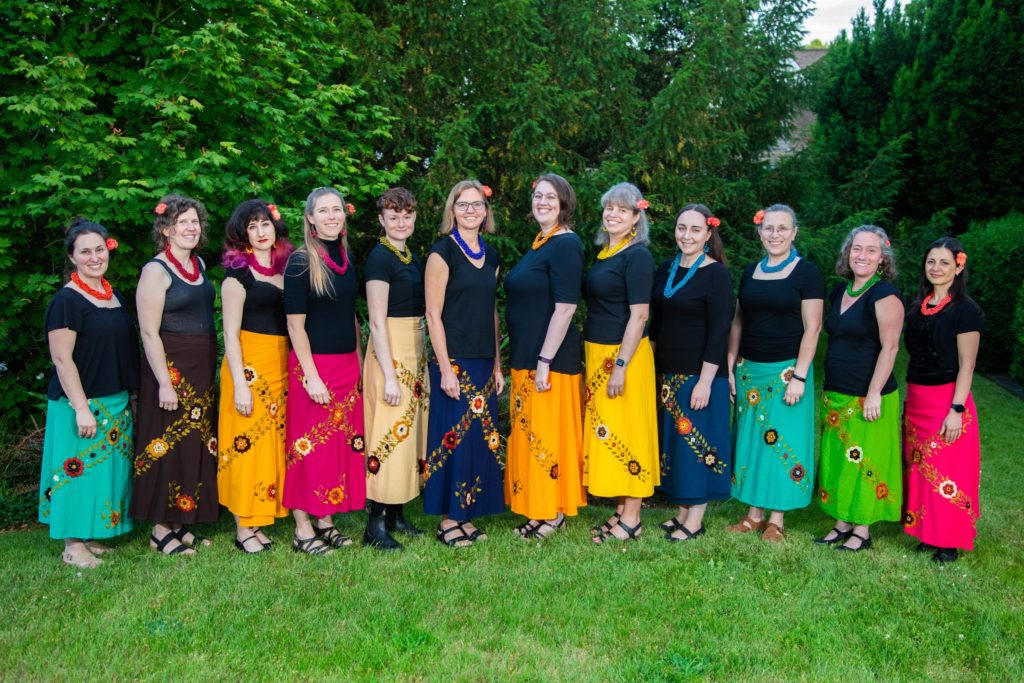Exploring Balkan Music in Seattle
“No one any longer believes that America is the great melting pot. Ethnicity is the word. We now know that we are not all one, that our diverse origins and backgrounds persist in spite of the best efforts of educators…”
With these words, S. Dillon Ripley, president of the Smithsonian Center for Folklife and Cultural Heritage, addressed the crowd gathered in 1974 at the Festival of American Folk Culture. This event was just one among many that emerged on the wave of the civil rights movement, the folk music revival, and efforts to democratize museum practices and diversify the content of cultural institutions (Cadaval & Diaz-Carrera 2014).
More than half a century later, at a similar folk culture festival in Seattle—now in its fifty-fourth year—I observe how cultural diversity sounds today and how the core premise that “we are not all one” has evolved. What new (musical) expressions has it found? The idea of cultural diversity, as something that must be preserved, can indeed be understood as one of the foundations of heritagization efforts. Yet we must also admit that it is a rather loose concept. What, in fact, do we preserve when we preserve cultural diversity? Which personal and social circumstances co-shape the modes and ideologies of preservation? And how does the relationship to cultural forms of the past reveal the intertwining of individual life stories with broader social, political, and cultural currents?
I came to the western part of Washington State in the United States, where I am involved in a one-month study exchange, because I am interested in Balkan traditional music—not only in its “original” form but especially in all its other versions. I am interested in music that travels and carries shifting symbolic and cultural meanings, through which the Balkans emerge both as a geographic and geopolitical space, as well as an imagery of the past and the primal qualities associated with it.
Seattle is home to a community of musicians, dancers, singers, and music enthusiasts of an older generation who are part of the slowly fading Balkan music scene, thoroughly described by Mirjana Laušević in her monograph Balkan Fascination: Creating an Alternative Music Culture in America. This scene developed from the International Folk Dance movement and blossomed in the 1960s, 1970s, and later, often as a result of the fascination with the exotic culture of the Balkans, the search for authenticity, and the romanticization of the Other (Laušević 2007). Many enthusiasts spent months or years in one or more Balkan countries, learning from local musicians. Upon their return to the United States, they became teachers of Balkan music and dance—and inevitably, cultural ambassadors.
At the Northwest Folklife Festival, the central event of my fieldwork experience, between learning kolo, singing old urban songs and melodies from the Bulgarian Šopi region, attending Romani music concerts, and evening Balkan parties, it becomes clear that the “Balkan fascination” has aged but remains alive. In a single evening on the dance floor, I meet almost all the dancers, musicians, singers, collectors, and enthusiasts who, in the past weeks, have generously shared their stories with me in Seattle’s cafés and parks, helping me understand the role of (Balkan) music in their lives.
Alongside the older generation are the singers of the Dunava choir—mostly American women without “Balkan” ancestry—and Bulgarian migrants who sing in the community choir Bulgarian Voices of Seattle. The dance group Radost impresses with its demanding choreography. My interlocutor, a professional dancer, has never been to the Balkans, yet she says that Balkan dance represents her cultural and symbolic homeland. Her earliest memories are of synchronized feet moving in the rhythm of kolo and interlocked hands, which she watched as an infant from her makeshift bed on the floor of a dance hall.

The performers of traditional or folk music I met are generally not part of institutionally supported heritage projects with a clear, pre-designed agenda. We rarely speak in the language of grand heritage narratives and discourses. However, slowly and gradually, we uncover seemingly spontaneous, sometimes more, sometimes less reflective musical practices, opinions, statements, motivations, affects, and emotions tied to the relationship to the past and to the Balkans. At times, I feel like a mere collector of such fragments, yet I am also aware that imaginaries and attempts to recreate the past often intertwine with other personal and social circumstances in diverse and sometimes unexpected ways. In relation to past cultural forms, such as traditional music, both the intimate and the broader social, cultural, and political dimensions are mirrored. For this reason, I pay close attention to the differences in heritagization processes among various groups and try to understand their relationship to the past in connection with their life stories.
Bulgarian Voices of Seattle is a women’s choir composed of members of the Bulgarian diaspora. This amateur choir has been active since 2011 under the auspices of the Bulgarian Cultural and Heritage Center in Seattle. For many singers, the choir is a space for socializing, conversing in their native language, and preserving the song traditions of Bulgaria, which they have internalized as their intimate and personal heritage in the process of migration. Among the Bulgarian singers, national heritage is closely connected to family legacy: they perform in traditional costumes with accessories often inherited from their ancestors. One of the choir’s past projects features songs that members had learned from their family members and friends.

Dunava is a smaller vocal ensemble composed of twelve singers—mostly white, middle-aged American women. Their connection to the Balkans and Balkan music is not based on national identification but rather on processes of cultural globalism and musical fascination. While Mirjana Laušević primarily discusses the romanticization and longing for “otherness” (Laušević 2007), and Ian MacMillen interprets the fascination with Balkan music as a form of affective engagement linked to the search for alternative identities and communities (MacMillen 2015), contemporary reflections on Balkan music among Dunava’s singers and other American performers also incorporate broader social and political currents. Here, musical heritage intersects with discourses of social justice, the emancipation of marginalized communities, thoughtful gender representation on stage, and negotiations of complex questions of cultural appropriation.

Some Bulgarian singers told me that before coming to the United States, they neither performed nor were familiar with Bulgaria’s folk song heritage. It was migration that set them on a path of seeking roots and tradition. They found it in Seattle, shaped by specific social circumstances and in a version born not out of rootedness but—out of migration itself. Their first teacher and conductor was, in fact, an American woman. She grew up in a dance community, became fascinated with the Balkans, and spent several years there learning to sing Bulgarian and Bosnian songs. Upon returning home, out of gratitude and a sense of duty, she founded a choir intended exclusively for women born in Bulgaria and guided them on a journey of rediscovering their songs.
In a certain sense, both the work of Dunava and Bulgarian Voices of Seattle can be understood as singing the songs of the Other—an imagined Other, situated in another temporality and spatiality. Yet it is precisely the fundamental premise that “we are not all one”—cultural diversity anchored in the idea of national identity—that allows Bulgarian women, unlike the Americans, to experience these songs as intimately their own. This process of internalizing heritage gives rise to certain differences in aesthetic choices and ideological orientations between the two choirs. Questions of proper vocal production and politically correct stage representation are less prominent among the Bulgarian singers. Authenticity, as a socially constructed criterion of artistic value, seems to arise spontaneously from their “Bulgarian-ness,” whereas the American choir must actively create it.
Both choirs are connected to a broader community of musicians, dancers, singers, and music enthusiasts. Heritage discourses among them unfold at the intersection of different coordinates: on the one hand, there is a reflective critique of the romanticization of the Balkans, not unlike academic criticisms of cultural essentialism; on the other, idealization and the search for authenticity persist—especially in the affective and embodied responses to Balkan music and dance. These are often understood as an alternative to individualized consumerism, expressed through the emphasis on the collective (and) physical dynamics of Balkan dances, characterized by holding hands and synchronized movement. There is nothing contradictory in this: music enthusiasts can simultaneously be aware of past state projects of curating and arranging traditional music (which, for example, created the most influential choirs for Balkan choral music, such as Filip Kutev and Le Mystère des Voix Bulgares), and at the same time remain affectively attached to practices they perceive as authentic, with ethnicity remaining one of authenticity’s contributing factors.
The fieldwork findings confirm one of the premises of critical heritage studies: ideologies and dominant discourses shape our understanding, perception, and conceptualization of past traditional practices. However, this does not mean that past cultural forms are somehow “tainted” by contemporary meanings. On the contrary—modern processes of cultural globalism, migration, the search for roots and authenticity, and, ultimately, the understanding of life as a project of self-realization have only enabled musicians to discover and fall in love with the traditional music of the Balkans. Through these processes, music has gained new meanings and emerged in new social contexts and roles—also as heritage.
References
- Cadaval, O. & Diaz-Carrera, C. (2014). The Smithsonian Folklife Festival and Cultural Heritage Policy in Colombia: A Case Study. Curator: The Museum Journal 57, 4.
- Laušević, M. (2007). Balkan Fascination: Creating an Alternative Music Culture in America. Oxford.
- Macmillen, I. (2015). Fascination, Musical Tourism, and the Loss of the Balkan Village (Notes on Bulgaria’s Koprivshtitsa Festival).« Ethnomusicology 58, 2.
